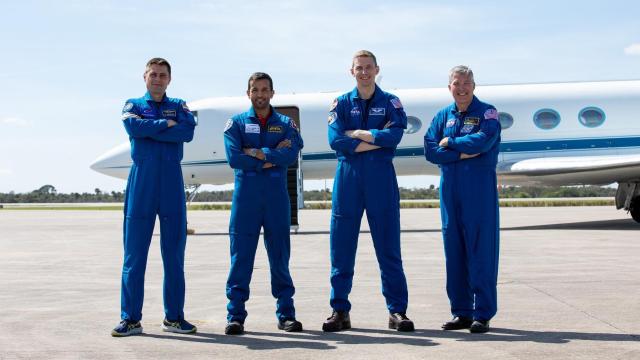A new astronaut crew is getting ready to cohabitate in low Earth orbit while conducting dozens of science experiments and research during a six-month period on board the International Space Station.
SpaceX’s sixth operational crewed flight to the orbiting lab will include two NASA astronauts, a Russian cosmonaut, and an Emirate astronaut as part of ISS Expedition 69. The four-person crew will work on a wide variety of research topics, including studying heart muscle tissue in microgravity, testing a bioprinter capable of printing human cells and tissue, and researching drug manufacturing technology.
When is Crew-6 launching?
NASA’s Crew-6 mission is scheduled to launch on Monday at 1:45 a.m. ET from Kennedy’s Launch Complex 39A, transporting four astronauts on board SpaceX’s Dragon Endeavour spacecraft to the ISS where they will spend up to six months in the orbiting laboratory. As always, SpaceX’s trusty Falcon 9 rocket will perform the lifting duties.
The launch was originally scheduled for Sunday but was pushed back to allow more time for the “preparedness of SpaceX’s crew transportation system, the space station, and its international partners to support the flight, as well as the certification of flight readiness,” NASA wrote in a blog post on Tuesday.
The Crew-6 astronauts arrived at the Kennedy Space Centre in Florida on Tuesday for final preparations ahead of launch where they will spend their remaining time on Earth in quarantine.
Who are the astronauts of the Crew-6 mission?
The members of the four-person crew are NASA astronauts Stephen Bowen and Warren “Woody” Hoburg, United Arab Emirates (UAE) astronaut Sultan Alneyadi, and Roscosmos cosmonaut Andrey Fedyaev.
Alneyadi will make history as the fourth Arab in space and also as the first Arab to go on a long duration space mission. He was selected by the Mohammed Bin Rashid Space Centre (MBRSC) to embark on this orbital journey as part of an agreement between NASA and Axiom Space. Axiom space was owed a seat aboard a Falcon 9 after the company gave up a spot on a Russian Soyuz rocket in 2021 for NASA astronaut Mark Vande Hei. In return, Axiom Space secured a seat on the Crew-6 mission, which it gave to MBRSC as part of another agreement.
Despite ongoing geopolitical tensions, a related agreement took place between NASA and Russia’s space agency Roscosmos whereby U.S. astronauts would ride on board Soyuz capsules while Russian cosmonauts strap themselves into a Crew Dragon in exchange. The agreement between the two parties did not involve money.
What will Crew-6 do on board the ISS?
Expedition 69 is packed with a variety of scientific investigations for the crew to delve into.
The National Institutes of Health is launching its Tissue Chips in Space initiative to study heart muscle tissue in a microgravity environment, which it’s doing to get a better understanding of heart disease. Another project will test an updated bioprinter that can print human cells and tissues in microgravity, which could one day be used on Earth.
The crew will also be conducting research for student-led projects from programs such as Genes in Space, an annual competition for students to design genetic experiments for a chance to test them on board the ISS.
Once Crew-6 makes it to the space station, Crew-5 members NASA astronauts Nicole Mann and Josh Cassada, JAXA’s Koichi Wakata, and Roscosmos cosmonaut Anna Kikina will return home aboard the docked SpaceX Endurance spacecraft.
Cosmonauts Sergey Prokopyev and Dmitry Petelin, and NASA astronaut Frank Rubio, will stay aboard the ISS until September, even after an uncrewed MS-23 Soyuz arrives later this week. The trio are currently without a reliable ride back home as their MS-22 Soyuz spacecraft was damaged by an apparent micrometeorite strike.
More: Russia Claims ‘External Impact’ Caused Second Spacecraft Coolant Leak at ISS
